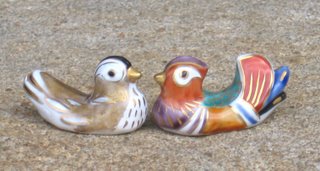:::::::::::::::::::::::::::::::::::::::::::::::::::::::::::::::::::::::::::::::::::::::::::::::::::::
Ireko 入れ子だるま Nesting Dolls
Matryoshkas (Russian nesting doll) Matreshka, Matrioshka
マトリョーシカ人形
ireko ningyoo 入れ子人形
Kumiko Nesting Dolls 組子だるま
kumiko gangu 組子玩具 nesting toys
Матрёшка
The origins of the Russian dolls are said to come from the nesting Hakone Daruma Dolls.
マトリョーシカの歴史はそんなに古くなく、19世紀末に日本の 箱根の入れ子だるま からヒントを得て作られ、万国博覧会に出品されたものが始まり、というのが定説です。またそのフォルムはこけしをモデルにしたとも考えられているそうです。



We also have some Daruma in this form in the museum.


Most come with five little dolls, Daruma Father, Daruma Mother and three children.
godan kaidanshiki no kumidaruma 五段式の組だるま


Photos from my friend Ishino
he loves me
he loves me not ...
matryoshka dolls
:::::::::::::::::::::::::::::::::::::::::::::::::::::::::::::::::::::::::::::::::::::::::::::::::::::
Five Daruma for Good Luck in Relationships
Goen Daruma 五縁だるま

Look at a lot more HERE !
© Kijidokoro Sato . 佐藤誠孝
Iwaki Town
:::::::::::::::::::::::::::::::::::::::::::::::::::::::::::::::::::::::::::::::::::::::::::::::::::::

© jbox Unazukin
:::::::::::::::::::::::::::::::::::::::::::::::::::::::::::::::::::::::::::::::::::::::::::::::::::::
Dear Gabi,
I have a Matryoshka (nesting dolls) Daruma, which starts out about two inches high, and has five dolls, four of which are hollow. In fact, although I got it long before there was an internet, I see it is now available on the internet:

http://www.houserice.com/nemida.html
Children are fascinated with this and another, Russian Matryoshka I have. Little children work mightily at trying to open the last, littlest doll that won't open, even after you tell them it won't open.
easily revealed
until you get to his core--
Matryoshka Daruma!
I was surprised to come across this Japanese connection to Matryoshka:
"Matryoshkas are a relatively new Russian handicraft; the first one dates from 1890, and is said to have been inspired by souvenir dolls from Japan. However, the concept of nested objects was familiar in Russia, having been applied to carved wooden apples and Easter eggs; the first Faberg・egg, in 1885, had a nesting of egg, yolk, hen, and crown.
"The story goes that Sergei Maliutin, a painter from a folk crafts workshop in the Abramtsevo estate of a famous Russian industrialist and patron of arts Savva Mamontov, saw a set of Japanese wooden dolls representing Shichi-fuku-jin, the Seven Gods of Fortune.
 The largest doll was that of Fukurokuju 福禄寿, a happy bald god with an unusually tall chin. It nested the six remaining deities. Inspired, Maliutin drew a sketch of a Russian version of the toy. It was carved by Vasiliy Zvezdochkin in a toy workshop in Sergiyev Posad and painted by Sergei Maliutin. It consisted of eight dolls; the outermost was a girl in an apron, then the dolls alternated between boy and girl, with the innermost a baby.
The largest doll was that of Fukurokuju 福禄寿, a happy bald god with an unusually tall chin. It nested the six remaining deities. Inspired, Maliutin drew a sketch of a Russian version of the toy. It was carved by Vasiliy Zvezdochkin in a toy workshop in Sergiyev Posad and painted by Sergei Maliutin. It consisted of eight dolls; the outermost was a girl in an apron, then the dolls alternated between boy and girl, with the innermost a baby."In 1900, was born M.A. Mamontova, the wife of Savva Mamontov, presented the dolls at the World Exhibition in Paris and the toy earned a bronze medal. Soon, many other places in Russia started making matryoshki of various styles."
http://en.wikipedia.org/wiki/Matryoshka_doll
And another site goes into more detail about the Japanese end:
 According to Hakone Town Office, Japan, products such as "Shichifukujin" and "Irokawari daruma (Daruma changeing colors)" have been created from Junitamago (12 Eggs inside each other).
According to Hakone Town Office, Japan, products such as "Shichifukujin" and "Irokawari daruma (Daruma changeing colors)" have been created from Junitamago (12 Eggs inside each other)."Shichifukujin" was shipped to Russia at the end of the 19th century, becoming a folkcraft called Matryoshika, or a nesting doll - i.e. doll having children. It is thought that Russian missionaries from the Russian church which used to be in Tohnosawa visited Hakone for the summer and took "Junitamago" back to Russia as souvenirs.
Let us explain what Shichifukujin means.

Hakone Seven Gods of Good Luck 箱根七福神
According Japan sources - Japan`s Shichifukujin--usually identified as Ebisu, Daikokuten, Bishamonten, Benzaiten, Fukurokuju, Jurojin, and Hotei--are traditionally believed to bring good fortune and happiness to people. The seven have long been depicted in painting, sculpture, song, and dance and began to be worshiped as a group several hundred years ago. The practice of making a meguri, or pilgrimage, to shrines and temples of all the Shichifukujin during the New Year season became popular during the Edo period (1603-1868). Shichifukujin Meguri are still popular everywhere in Japan--including the Fukagawa and Kameido districts of Tokyo`s Koto-ku.
http://www.rus-sell.com/article52-Russian+nesting+dolls.html
Your friend Larry
:::::::::::::::::::::::::::::::::::::::::::::::::::::::::::::::::::::::::::::::::::::::::::::::::::::

source : thepockymonster.deviantart.com
:::::::::::::::::::::::::::::::::::::::::::::::::::::::::::::::::::::::::::::::::::::::::::::::::::::

away from their nest . . .
all five matryoshka dolls
celebrate girls day
- Shared by Elaine Andre
Joys of Japan, March 03, 2012
. Hina Doll Festival (hina matsuri 雛祭り) .
:::::::::::::::::::::::::::::::::::::::::::::::::::::::::::::::::::::::::::::::::::::::::::::::::::::

cheerful concert
main role
straw dolls
- Shared by Gennady Nov
Joys of Japan, March 2012
:::::::::::::::::::::::::::::::::::::::::::::::::::::::::::::::::::::::::::::::::::::::::::::::::::::
Seven Gods of Good Luck
Daruma Museum
. Regional Folk Toys from Japan .
:::::::::::::::::::::::::::::::::::::::::::::::::::::::::::::::::::::::::::::::::::::::::::::::::::::








1 comment:
マトリョーシカ最後は燐寸擦りにけり
matoryôshika saigo wa macchi surinikeri
matryoshka dolls
at the very end
a match lighted
嵯峨根鈴子
Sagane Suzuko
(Tr. Fay Aoyagi)
.
Post a Comment